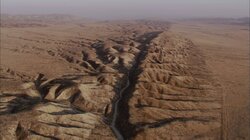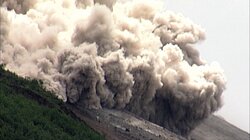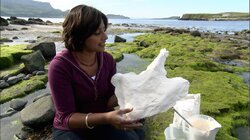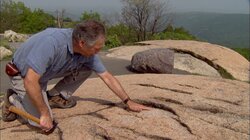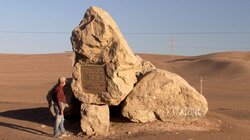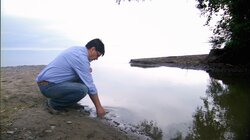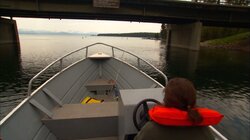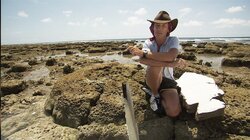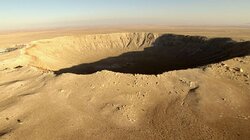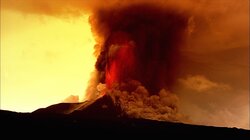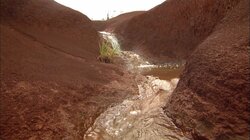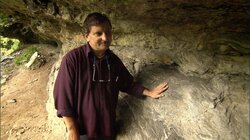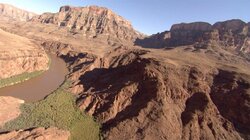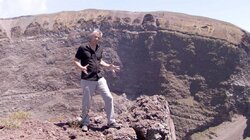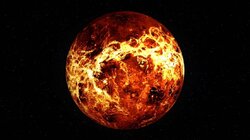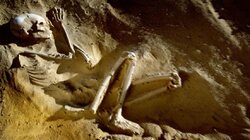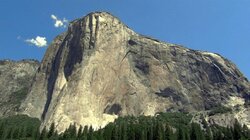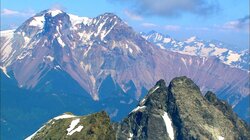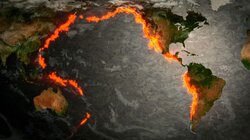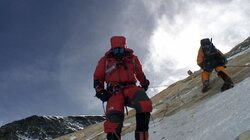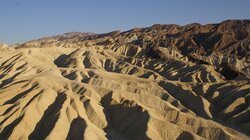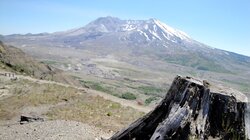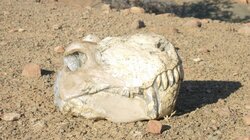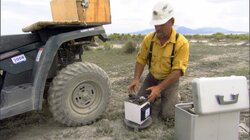Season 1
Episode: 1x01 | Airdate: Feb 10, 2009
The San Andreas Fault runs roughly 800 miles through some of the most valuable real estate in the world. The southern section hasn't had a significant quake for over 300 years and is now primed and ready for another "big one." Take a trip along the most famous fault line in the world and examine the geology that gives it its immense destructive power. It's an investigation given new urgency by recent warnings from 300 of America's leading scientists about the death and devastation that a major earthquake on the fault could unleash on Los Angeles.
Episode: 1x02 | Airdate: Feb 17, 2009
The Marianas Trench is the deepest place on earth, deeper than Mt. Everest is high. The trench is where the ocean floor disappears into the center of the earth. The pressures at this depth are 17 times greater than what it takes to crush a nuclear submarine. Only two men have ever been down the Trench, fewer than have set foot on the moon. Follow the daring missions into the abyss and explore the extraordinary geology that has created this deep scar along the ocean floor.
Episode: 1x03 | Airdate: Feb 24, 2009
On August 27th, 1883 a series of blasts on the island of Krakatoa culminated in a colossal explosion that blew the island apart in one of the largest eruptions in recorded history. We explore the underground forces that led to this extraordinary explosion that killed over 36,000 people and the devastation that it caused. But this is not just history because Anak Krakatoa (the Son of Krakatoa) is growing bigger and bigger and will blow again.
Episode: 1x04 | Airdate: Mar 3, 2009
Home to the legend of the Loch Ness Monster, this lake holds more water than any other lake in Britain. It's only 10,000 years old, but billions of years in the making. Trace the extraordinary story of Loch Ness: from the three billion year old bedrock of Northern Scotland, to the giant glaciers that carved out the Loch. On this incredible journey we reveal that Loch Ness was once part of America, giant dinosaurs, suspiciously similar to the fabled monster once roamed the area, and that the entire region was engulfed by huge volcanic eruptions as Scotland was ripped from its birth place on the American continent. Could the mythical Loch Ness monster be a descendant of the dinosaurs, somehow surviving in the murky waters of the loch?
Episode: 1x05 | Airdate: Mar 10, 2009
New York is one of the most man-made spaces on the planet, but everything from the height of the skyscrapers to the way the subway was constructed to the position of the harbor is governed by the extraordinary forces that ultimately shaped this city. You can tell the geology of Manhattan at a glance by looking at the skyline. The skyscrapers of Midtown and Downtown are built on hard granite; the low-rise buildings in between are built on a soft, gravelly soil left over from the Ice Age. In this episode of HOW THE EARTH WAS MADE, viewers learn how New Jersey and North Africa were neighbors 250 million years ago, how the rocks New York are built on are the remains of mountains that 450 million years ago were as tall as the Himalayas, and how Long Island is covered in rubble that dumped as ice sheets retreated 10,000 years ago.
Episode: 1x06 | Airdate: Mar 17, 2009
The Atacama desert is considered the driest place on Earth. Since human records of the area began, some places have never received rain. But the records don't stop there--the Atacama is also the oldest desert in the world, and recently it has been dated to an amazing 150 million years old. Other research shows that the surface of this desert is also incredibly ancient, with boulders lying there that have not moved for over 23 million years--more than 50 times longer than it's taken for our human species to evolve. The soil is so dry, it has been used as a test bed for the Mars rovers. And though the desert was once thought to be completely lifeless, strange bacteria discovered there have given scientists new hope that they might find life on the red planet. Atacama is also home to the largest copper mine in the world. Inspect the riddle of the Atacama and uncover how this extraordinarily dry landscape was created.
Episode: 1x07 | Airdate: Mar 24, 2009
The Great Lakes of North America are the largest expanse of fresh water on the planet. Searching for clues of their formation, our geologists delve deep into an underground salt mine, investigate a fossilized coral reef, climb an Alpine glacier, and dive to the bottom of Lake Superior. They find evidence of an ancient tropical sea, a mighty rift that almost tore the continent in half, and a mile high ice sheet that repeatedly carved its way across North America. And as the lakes settle to their current levels, cascading over Niagara Falls, we find that their evolution is far from over.
Episode: 1x08 | Airdate: Mar 31, 2009
Yellowstone National Park is one of the most dangerous geological features on Earth. In trying to uncover the processes behind Yellowstone's main attractions like "Old Faithful," geologists came to the frightening realization that Yellowstone was in fact a vast hidden super-volcano -- one that is overdue for a massive eruption. Yellowstone has been on a regular eruption cycle of 600,000 years but the last eruption was over 640,000 years ago, so the next is overdue. An eruption at Yellowstone could be 2,500 times the size of the 1980 Mount St. Helens event. In the past 16.5 million years, the volcano has mysteriously moved 100's of miles though Nevada across southern Idaho to reach it's present loaction in Yellowstone. But even today it is still active. A swarm of 500 earthquakes hit the park early in 2009 and geologists found that the entire Park is being pushed up into the air by hidden forces under the ground. Is this sleeping giant beginning to stir?
Episode: 1x09 | Airdate: Apr 7, 2009
Tsunamis are one of the most terrifying forces of nature, destroying all in their path. The December 26th Tsunami is estimated to have released the energy of 23,000 Hiroshima-type atomic bombs. What are the enormous forces that generate these catastrophic waves deep on the ocean floor? With 50% of the world's population living within a mile of the sea, this episode looks at what could happen in the future. East coast cities from New York to Miami face the threat of a truly colossal wave that could be generated by the collapse of an active volcano off the coast of Africa.
Episode: 1x10 | Airdate: Apr 21, 2009
These giant mountain sized boulders from space have wrought death and destruction throughout the millennia but until recently geologists could find no evidence that they had actually struck the earth. How the Earth Was Made follows the remarkable detective story that begins at Meteor Crater in Arizona as mining engineers desperately try to unearth the billion dollar iron boulder they thought was lying there. It's a detective story that also uncovers immense riches; the world's biggest nickel deposit in Sudbury, Canada, vast oil reserves in the Gulf of Mexico and a Gold mine in South Africa - all the result of asteroid impacts. Evidence is also unearthed of violent impacts that decimated some of the first people to live in America. And finally Asteroids, and their smaller cousins Meteorites, could also hold clues to the formation of the early earth and perhaps life itself.
Episode: 1x11 | Airdate: Apr 28, 2009
Iceland is the largest and most fearsome volcanic island on the planet. Scouring the island for clues, "How the Earth Was Made" hunts for clues to the mystery of what powerful forces are ripping Iceland apart, and lighting its fiery volcanoes. Here lava rips huge tears in the ground and new islands are born from the waves. Yet Iceland has a history of being covered in, and carved by ice. Locked in a titanic battle, fire and ice collide as glaciers explode and cataclysmic floods decimate the landscape. But Iceland's volcanoes have had ramifications far beyond the shores of Iceland, causing climatic chaos and devastation across the planet; a fate which may one day happen again.
Episode: 1x12 | Airdate: May 5, 2009
The Hawaiian islands are the remotest island chain on the planet. Emerging in the centre of the Pacific their origins have remained a puzzle for generations. "How the Earth Was Made" follows the story of our attempts to try and understand these beautiful and yet violent islands. A story of raging volcanoes, vast landslides, mega-tsunamis and strange forces emerging from the bowels of the planet. We reveal that Hawaii's Big Island is over 25 times bigger than mount Everest, that the entire Island chain is disapearing faster than any other land mass on Earth and that volcanoes here might hold essential clues as to the inner workings of our planet.
Episode: 1x13 | Airdate: May 12, 2009
The jagged backbone of Europe, spanning seven countries and providing essential water to millions, the Alps are Europe's most important landmark. But how did marine fossils get here, seven thousand feet above sea level? A team of investigators as far back as Leonardo da Vinci attempt to fathom out how the Alps evolved, a story that takes us to the bottom of the sea, up the slopes of the infamous Eiger and Matterhorn and deep into the heart of a glacier. But these iconic peaks won't be here for long. Mountains are tumbling down, glaciers are melting and the Alps are being washed away.
Season 2
Episode: 2x01 | Airdate: Nov 24, 2009
Almost 200 miles long and over a mile deep, this deep scar in the American Southwest is easily visible from space. You could stack five Empire State Buildings one on top of the other--and they still wouldn't reach the lip of the Canyon. As the Pacific grinds into the North American plate, a giant plateau has been pushed up over a mile in the air. Meanwhile, the Colorado River has been draining the Rockies, and with its thick load of sediment, continues to carve this amazing canyon in the rising plateau.
Episode: 2x02 | Airdate: Dec 1, 2009
Mt Vesuvius is the world's most dangerous volcano, and it threatens three million people. It was responsible for the most famous natural disaster of ancient history, the eruption that destroyed the Roman city of Pompeii. And its most recent blast was caught on film in 1944. Today Vesuvius is the most densely populated volcano in the world. Now recent scientific discoveries show that it is capable of an eruption larger than ever before thought possible and that hidden beneath Vesuvius there is a vast magma chamber of boiling hot rock, ready to come out.
Episode: 2x03 | Airdate: Dec 8, 2009
Four and a half billion years ago the Earth formed from dust in space to become a molten ball of rock orbiting the Sun. This episode travels back in time to investigate how the fledgling planet survived a cataclysmic cosmic collision with another world, how molten rock solidified to land, how our oceans filled with water and how life arrived on Earth. Geologists study the oldest rocks on Earth and meteorites from outer space to solve the greatest geological mystery of all--the Birth of the Earth.
Episode: 2x04 | Airdate: Dec 15, 2009
Africa's Sahara Desert is the size of the United States, making it the largest desert in the world. It's also the hottest place on the planet. But now an astonishing series of geological discoveries has revealed this searing wasteland hides a dramatically different past. Scientists have unearthed the fossils of whales, freshwater shells and even ancient human settlements. All clues to a story that would alter the course of human evolution and culminate in biggest climate change event of the last 10,000 years.
Episode: 2x05 | Airdate: Dec 22, 2009
The Sierra Nevada, North America's highest mountain range, contains one of the most awe-inspiring geological features on the planet: Yosemite Valley. Walled by sheer 3,000-foot granite cliffs and made from one of the toughest rocks on earth, it is home to the mighty El Capitan and iconic Half Dome. Yet how this extraordinary valley formed has been the subject of controversy for over 100 years. Was it carved by gigantic glaciers or a cataclysmic rifting of the Earth?
Episode: 2x06 | Airdate: Dec 22, 2009
From Alaska to New Mexico, the Rockies are one of the great mountain belts of the world--caused by tectonic forces of the Pacific Plate pushing against the North American continent. They have formed as the earth's continental crust has been shortened under pressure--by around 1 inch a year. What's more, they are still rising and they are still young in geologic terms: when the dinosaurs roamed the Earth they had not even started to form.
Episode: 2x07 | Airdate: Jan 12, 2010
The single longest linear feature on Earth--the "Ring of Fire" circles almost the entire Pacific. It is a ring of active volcanoes from White Island just north of New Zealand, through the South China seas, Japan, Kamchatka, the Aleutians, the Cascades and down through the Andes. Almost 25,000 miles long, it is one of the most awesome sights on Earth.
Episode: 2x08 | Airdate: Jan 19, 2010
It is the tallest and biggest mountain on earth, as far removed from sea level as it's possible to be--and yet its sedimentary layers contain fossils that were once creatures that lived on the ocean seabed. The Himalayas formed when India smashed into Asia--propelled by plate tectonics. Everest is still rising but its height is limited--extreme erosion counteracts and limits the amount of uplift.
Episode: 2x09 | Airdate: Jan 26, 2010
It is not only a place of natural splendor but a geologic treasure trove as well. Hidden in the sediments of the rocks in its walls is evidence of the coldest time on our planet--ironic in one of the hottest places on Earth. Death Valley is literally being pulled apart and the floor is collapsing and lower than sea level. Here and across much of Nevada is the Basin and Range province--a series of ridges of mountain ranges that are being pulled apart and the basins between them getting wider and flat as they fill with eroded sediment.
Episode: 2x10 | Airdate: Feb 2, 2010
Over 20 years ago, Mt. St Helens--thought to be dormant--shocked America when it exploded. It is an acidic volcano--the magma beneath is full of volatiles making it highly explosive. A new plug has formed in its throat and is rising. When it blows it will be like uncorking a champagne bottle, releasing pressure below and allowing dissolved gases to escape and explode. The question is...when will it blow again?
Episode: 2x11 | Airdate: Feb 9, 2010
In the remote wastes of Siberia buried under snow are the remains of one of the greatest catastrophes that the Earth has endured. 250 million years ago, huge volumes of lava spewed out onto the surface--so much that it would have buried the whole of Texas under one mile of lava. At first the temperature dipped but then the greenhouse gases that escaped from the depressurized lava caused a massive global warming. It wreaked havoc and 95% of the species on Earth became extinct. Yet life hung on and in time this disaster paved the way for the next great phase of life on earth--the age of the dinosaurs.
Episode: 2x12 | Airdate: Feb 16, 2010
Why do we have ice ages and when is the next one due? Chart the progress of different ice ages through the history of our planet, from Snowball Earth hundreds of millions of years ago to the recent ice ages. As the Earth circles the sun, its orbit changes slightly and so does it angle of rotation. When the right wobble in our rotation combines with the right orbit, the Earth is, and will again be, plunged into an ice age--but maybe not for a few thousand years.
Episode: 2x13 | Airdate: Mar 2, 2010
Gold dates from the time of the supernova explosion that gave birth to the building blocks of our solar system. When it was created, the Earth included a tiny percentage of gold atoms, and over the aeons geologic processes have concentrated it into various nooks and crannies around the globe. The best of it is in the ancient Precambrian rocks in South Africa, where the deepest mines in the world extract it. In other regions of the world, gold can be gathered from younger sedimentary rocks that have been eroded off older Precambrian rocks. The American gold rush was this type of deposit. Now in Nevada, sedimentary rocks are leached on a truly vast scale to extract the gold.



